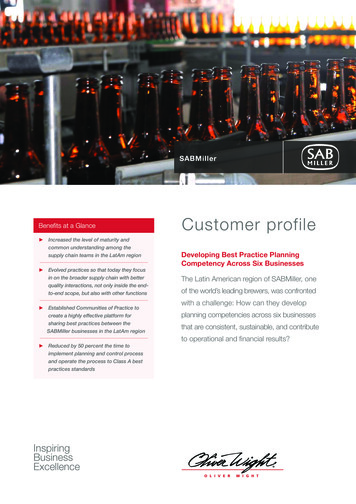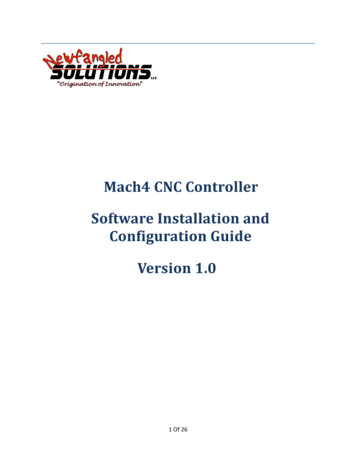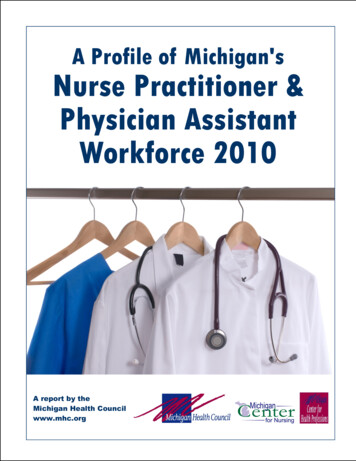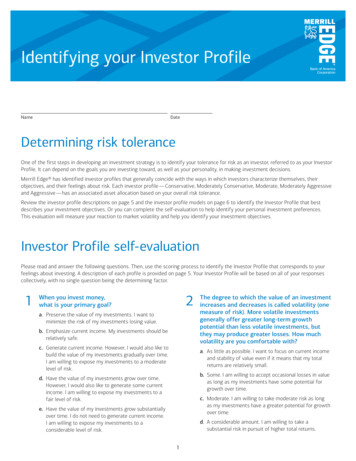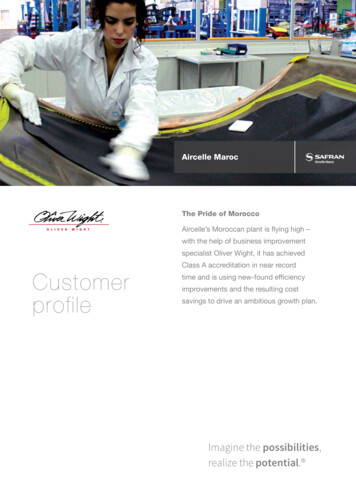
Transcription
www.oliverwight-eame.comOliver Wight EAME – Customer Profile – Aircelle MarocAircelle MarocThe Pride of MoroccoAircelle’s Moroccan plant is flying high –with the help of business improvementspecialist Oliver Wight, it has achievedCustomerprofileClass A accreditation in near recordtime and is using new-found efficiencyimprovements and the resulting costsavings to drive an ambitious growth plan.Imagine the possibilities,realize the potential.
www.oliverwight-eame.comOliver Wight EAME – Customer Profile – Aircelle MarocOpened in 2006, Aircelle Maroc sits close to Casablanca airport. It is an impressive facility,with 20,000 sq m of high-tech assembly lines, semi-clean rooms and bright modern offices.It supplies nacelles, thrust reversers and carbon fibre composite components for airliners andexecutive jets. This is a fast-paced business which is growing at the rate of 20% per annum– and now it is gearing up for major new contracts with the help of Class A Planning andControl from business improvement specialists Oliver Wight.Aircelle is part of the 10 billion, 55,000 employee Safranthe engine itself. As well as its critical aerodynamic andgroup. The French-owned multi-national operates in 50structural properties, it also includes sophisticated acousticcountries and operates in three core markets: aerospace,and de-icing systems – the nacelle dampens noise from thedefence and security. Group products range from biometricengine, reducing it by as much as 90%, and it has to copepassports to missile propulsion systems, helicopterwith extremes of temperature, ranging from several hundredlanding gear and engine casings for jet aircraft. This lastdegrees inside, to minus 50 or 60 degrees outside.area is where Aircelle operates and it is the Europeanleader in design, production and aftersales for nacellesThough part of the Safran group, Aircelle is a sizeable– the ‘pods’ which house aircraft engines – and reversebusiness in its own right, with a turnover of 700 millionthrusters. Customers include major engine and airframeand 3,000 employees. There are seven sites: Le Havre (themanufacturers, such as Airbus, Gulfstream, Rolls-Royce,largest plant and HQ), nearby Pont Audemer (the EuropeanPower Jet, Sukhoi and Comac.service centre); Burnley in the UK; Plaisir, near Paris (designand customer support); Florange in north eastern France;Accounting for three quarters of Aircelle’s manufacturingCasablanca in Morocco; and Toulouse, which is situatedoutput, the nacelle is almost as complex a product asopposite the Airbus plants and which supplies the airframer1
www.oliverwight-eame.comOliver Wight EAME – Customer Profile – Aircelle MarocBenoit Martin-Laprade, General Manager of AircelleMaroc, says the strategy for his company is to be acentre of excellence and a key player within the Aircellegroup, delivering high quality, high volume production withlow levels of support – products are typically designedand developed elsewhere in the group and productiontransferred to Morocco when it is stable. “We don’t intend todesign new aircraft nacelles here. Our skills are to producegood quality products which are already mature,” he says.Most of Aircelle Maroc’s production (70%) is the doors andinlet structures for reverse thrusters for the A320 Airbus;25% is complete nacelles for the Rolls-Royce engine fittedto Gulfstream and Bombardier executive jets. The remaining5% is manufacture of various carbon fibre components.Demand for executive jets has remained unabated at100 aircraft a year.While Morocco may not be uppermost in people’s minds asa prime manufacturing location, Benoit says they are wrongto assume this is a second rate operation: “We are a worldclass organisation in a low cost country. We implement thesame standards here as we do everywhere else in Aircellewith complete propulsion assemblies, with the engine– in fact, if possible, we do so before the other sites inhoused in the nacelle and painted in airline customer’sthe group.” Aircelle Maroc has received widespreadlivery. Aircelle supplies nacelles for aircraft ranging fromrecognition locally for quality and the management of core20-seater regional and business jets (representing 24% ofpractices and is now the first site within Aircelle to achieveits business), to medium range airliners like the A320 (24%)the Oliver Wight Class A standard for production planningand long range airliners like the A380 (43%). It producesand control. In fact, it is the first non-French site within themore than four completed nacelles every day and there areSafran group to achieve the Class A standard – and the firstcurrently more than 12,000 of its units in service, producingever company in Morocco. Oliver Wight consultant Jean-one reverse thrust somewhere in the world every fourPierre Fauverghe says it is a classic story of service up;seconds. The company is growing rapidly.productivity up; and stocks down, “but the company hasachieved Class A with real panache,” he adds. Indeed, theAircelle operates in a unique market. The lifecycle of anresults and the speed with which they were delivered areaircraft is roughly the same as that of a man, at 75 years.impressive – Oliver Wight conducted its first diagnostic ofNew aircraft are typically in the design and developmentthe Casablanca plant in January 2009 and the site achievedstage for 12 years; they spend 30-35 years in productionClass A just 18 months later, in June 2010.followed by 30 years of aftermarket sales, before beingplaced in retirement. Those of us in our 50s and 60s have20% annual growthalready spent our whole life with the Boeing 747 ‘jumboBenoit is justifiably proud of the plant’s Class A status and isjet’, but new 747s are still being manufactured. Similarly,determined to continue on the same upward path, planningthe A320 has already been around for 30 years and today’sfor 20% growth every year for the next five years. Thegeneration of children will spend all their lives with the giantbusiness is already on track to meet his goals: productionAirbus 380. This is a market where technology is changinghours increased from 360,000 in 2009 to 400,000 in 2010,rapidly but where new (airframe) products are rarelyand are targeted to reach almost 500,000 by the end ofintroduced.2011. The increase will be achieved through a combination2
www.oliverwight-eame.comOliver Wight EAME – Customer Profile – Aircelle Marocof improved efficiency, driven by the Class A programme,new business and the transfer of production fromother plants.It is a mark of the site’s success and the confidence of itscustomers that it now supplies some airframe manufacturersdirect. Aircelle Maroc makes reverse thrusters for theRolls-Royce BR710 executive jet engine and Rolls Royce’scustomers are Bombardier (in Belfast) and Gulf Stream (inGeorgia). Now, as a result of production quality and deliveryperformance, Rolls-Royce permits the Maroc plant to shipdirect to its clients. This is viewed as an achievement withinthe group, too – when production moved from Le Havre toCasablanca, a full time quality controller from Rolls-Royce,who had worked on the line in Le Havre for three years,moved with it. Within 18 months, Rolls-Royce recalled theengineer because he was no longer required.Achievements such as these have been driven by theClass A programme, says Benoit. “We have confidence inour ability. We know whatever project we take on, Class Agives us the methodology to deliver against the customer’sPO; we aren’t starting from scratch every time. That inturn spreads confidence to our customers as well as tocomposite components ourselves rather than buying themthe rest of the Aircelle group,” he says. Aircelle Maroc onlyin,” says Benoit.began operating in 2005, when initial work began with 10employees, all of whom remain today. The current plantAircelle Maroc is a young company in every respect: thewas opened in 2006 and the 10,000 sq m shopfloor wasaverage age of the workforce is 29 years and six months.doubled in 2008 to enable transfer of the BR710 nacelleAlmost a quarter of the workforce is female and staffproduction from Le Havre. Since 2006, turnover has grownturnover is just 8% per annum.from 10 to 67 million and the site now employs nearly 400people.The Class A programme was introduced by Aircelle HQto improve service levels, and is managed by StrategicEmployee numbers may have leapt dramatically since thePlanning Director Fabrice Volard. It is part of a broadersite was established, but achievement of Class A meansClass A initiative and Oliver Wight’s Jean-Pierre Fauverghe,that continued growth can be met, in the main, throughalso works with other divisions of the group: The Le Havreincreased output as efficiency improves. Revenues areplant, for example, achieved Class A for External Sourcingforecast to pass 100 million by 2014 with 600,000and for Integrated Business Planning (Advanced Sales andproduction hours – an increase of 50% from current levels –Operations Planning) in June 2010, while the customerbut headcount will only increase by around 10%. Currently,support division has recently received Class A for Logistics.two thirds of revenues come from the assembly of nacellesand a third from the manufacture of carbon fibre compositeIn fact, explains Fabrice, it is also one of the most importantcomponents, but Benoit expects the ratio to be 50:50 byprojects in the broader improvement plan, for the SAFRAN2014. “We’re planning for 20 percent annual growth butgroup itself (‘SAFRAN ’). This bridges all sectors of thethe use of composite components in aircraft manufacture iscompany and includes a lean project “Xcellence”, whichincreasing all the time, so it will become a greater proportiongoes hand in hand with Class A. “The Aircelle Marocof our business – and we will be manufacturing moreClass A programme has the full support of the Aircelle3
www.oliverwight-eame.comOliver Wight EAME – Customer Profile – Aircelle Marocstock: “When we shifted the focus to weekly targets, therewas an immediate improvement in performance,” he says.Since achieving Class A, the company has gone furtherand introduced daily targets (from January 2011) and thisresulted in yet more improvement.Now that production levels have been smoothed out,there is no longer requirement for weekend working tomeet targets, so saving additional cost. Also, buffer stockbetween Maroc and Le Havre has been halved, aided by theintroduction of direct delivery to the airframers. The savingsrun into hundreds of thousands of Euros and the companyhas received formal congratulations from Rolls-Royce for its‘class-leading’ OTIF delivery achievements.Daily production targets have been welcomed throughoutthe organisation. Head of production, Gilles Delahoullière,is a long-serving Aircelle employee; he has been with thecompany since 1971 and worked at Maroc from day one,and says this has been the by far the most important periodin the company’s short history: “It is much better for us tohave a daily focus on production and much easier for peopleto work with daily targets.”steering committee, through the central Oliver Wight S&OPprocess in Le Havre,” he says. “And S&OP is now the realAnd shopfloor manager, Noureddine Ribqi – another foundermanagement and decision-making tool of the company; itemployee – agrees. “Dividing the weekly target by five allowshas not only improved our processes but has also helped usus to see much more clearly how we are progressing againstoptimise the accuracy and reliability of our ERP system.”our objectives, and we don’t have to play catch up at theend of the month. If we have staff absence, I can easilyAt the start of 2009 when Aircelle Maroc began to work withrebalance the line, so we can maintain the takt time andOliver Wight, the site’s business model was quite different.still meet our objectives. Before, I had eight people in theIt had just one customer, the Le Havre factory, and servicefinishing section, so we could make up time at the end oflevels (as measured by the sales and operation planningthe month; now I only ever need two.”process in Le Havre) were somewhere between 70% to80%. When Class A took hold, OTIF increased to 100%Ludovic Boisrame says one of the key enablers was thealmost immediately and has remained at that level ( /- 2%)breakdown of barriers between functions, which wasever since.underpinned by the Class A work. As soon as everybodywas working from a single set of data, it was easy to seeLudovic Boisrame is supply chain manager at Aircelle Maroc:where improvements could be made and measured. “Wehe says that focusing production schedules into shorterwere operating in silos before and the change in mindsettimeframes made a significant difference to performance.was everything. As soon as people started to understand“Master schedule adherence has improved from 65% toeach other and work together, it made a huge difference,”95%, because we made a fundamental shift by setting thehe says.MPS objectives weekly instead of monthly,” he says.Stock accuracy has always been excellent at the MarocBefore then, 60% of the monthly production schedule wasplant – but even here, there has been some improvement.being completed right at the end of the month and put intoThe Class A programme has enabled the business to4
www.oliverwight-eame.comOliver Wight EAME – Customer Profile – Aircelle Marocreduce its stockholding by a third, from 120 days to 80,with considerable savings: “It’s worth 7.5 million, or about 30,000 every working day,” says Ludovic. There have beendramatic reductions in manufacturing cycles, too: assemblyfor the A320 unit is down from 12.75 days to just eight, andthis is targeted to reduce even further to six days. For theIFS inlet structure, manufacturing time has been cut from 33days to 25; on the A320 composite parts, it’s a huge dropfrom 62 to 27 days.Benoit believes the results from Class A have gone beyondprocess improvement and have had a powerful impacton Aircelle Maroc’s reputation. “It is a globally recognisedstandard and it really means something to our customersall over the world. Class A underpins our ability to grow andchange. Confidence is the key word; whenever we get anew programme from France, we can be absolutely certainwe can set off on the right track,” he says.Methodology and structureClass A is crucial for continuous growth, he says: “Class Agives us a methodology, a structure, and you need that ifyou plan to grow by 20% every year. There’s no doubt thatClass A helps us secure new business. And we know we“You don’t need a computer to see how things are going;can do it without having to increase inventory.it’s visible on the line. When we introduce new projects in thefuture, we know exactly what we need to do,” says Benoit.“It creates a virtuous circle: it’s like buying milk in theHR director Yamina Kassabi has been with Aircelle Marocsupermarket. If you’re used to buying your litre of milk everysince day one. She epitomises the youth and enthusiasm ofday and one day you find the shelves are empty, the nextthe operation, and is an enthusiastic supporter of Class Aday you buy two cartons just to be on the safe side, whichwhich, she says, has fast become the new way of workingstarts to throw everything out.” With the improved dailyfor the entire site. Class A is embedded in everything theydistribution of schedule objectives, also come efficiencies indo, in all daily activities, she says. The way everyone workedlogistics. There are now two scheduled deliveries from theso hard to achieve Class A reflects, says Yamina, the specialplant to Le Havre every week: on Wednesdays (which takescharacter of the Moroccan people and the youth of theproduct finished on Monday and Tuesday) and Saturdaycompany.(which takes output from Wednesday to Friday). Customeragreements mean Maroc can deliver up to seven days in“Moroccans are, by nature, very proactive: When presentedadvance of the due date. Deliveries are never late.with something new, they really seize the task in hand andare capable of extraordinary things in extraordinarily littleTakt time on the A320 section is set at one aircraft per day:time. If you say to them, today, that these are the things youtwo engines mean eight reverse thruster doors (there areneed to do to achieve excellence, they will start to achievefour lines; one for each door). Lineside kanbans replenishresults tomorrow or the next day. They react very quicklyparts twice a day. The takt time for the BR710 is based onbecause they really want to prove what they are capable of.2.5 aircraft (10 doors) per week. The finishing section catersIt’s ‘la fierté marocaine’; Moroccan pride.”for both the A320 and BR710 and the takt time is set ateight doors per day – all of this is determined by demand forYamina says despite some initial reservations about whetherthe complete aircraft (100 per annum in total).Class A would be difficult, the workforce has taken to it5
www.oliverwight-eame.comOliver Wight EAME – Customer Profile – Aircelle Marocenthusiastically and everyone has grown in confidence:too. They now look beyond their own roles and see“There were no difficulties implementing Class A. Peoplethemselves as part of a greater team.”are working much better together now.” It is clear that asa business, Aircelle Maroc is very close to the shop floorFoundation for growthand Yamina in particular takes a day-to-day interest. EveryLooking to the future, Benoit says Class A will be themorning she tours the factory with Gilles Delahoullière andfoundation for growth at Aircelle Maroc. A new line forBenoit is only half joking when he says she claims the creditthe nacelle for the Russian Sukhoi Super Airliner will befor meeting daily targets: “she says the results are all downinstalled this year – Maroc already makes composite partsto HR because it is people that deliver results,” he says.for this airliner but is about to take on production for theentire nacelle, delivering direct to the engine manufacturer,The cultural improvements run far and wide, as cited byPower Jet. Similarly the nacelle assembly line for thePierre Champtiaux, head of manufacturing engineering. Annew Bombardier Learjet 85 is to move from Le Havre toAircelle employee for seven years, he has been at the MarocCasablanca.plant for the past two. Having previously worked in supplychain, he understands only too well the benefits of improvedMost significantly, Benoit says, this nacelle will include thecommunication between supply chain and manufacturing.first part ‘industrialised’ by the Moroccans: “We developed“Manufacturing people tend to just view themselves as thethe component for production here, rather than inheritingpeople that make things; they don’t see themselves asit from Le Havre, as we usually do. It is another big steppart of planning. But, with Class A, they are able to see theforward for us,” he concludes.benefits of working as a team and treating supply chain asan internal customer. Of course, they like nothing less thanAircelle Maroc is a site with powerful ambitions and it hasunstable lead times – so the stability that came with Classthe processes, the structure and the capability to pursue itsA allows them not only to achieve their individual KPIs, butplans with all the confidence that Class A brings. Perhapsit frees them up to drive technical lead time improvements,most important of all, it has la fierté marocaine.6
www.oliverwight-eame.comOliver Wight EAME – Customer Profile – Aircelle MarocWhen you talk to Oliver Wight about improving your business, we’ll assume you want results, notjust better processes - things like increased revenues and margins and greater market share. Ifyou have the ambition, it is possible to make improvements that truly transform the performanceof your organization and create more fulfilling roles for the people within it. We believe thiscan only be delivered by your own people. So, unlike other consultancy firms, we transfer ourknowledge to you; knowledge that comes from nearly 50 years of working with some of theworld’s best-known companies.Oliver Wight EAME LLPThe Willows, The Steadings Business CentreMaisemore, Gloucester, GL2 8EYT: 44 (0)1452 me.comOliver Wight Asia/Pacific118/3 Male Street, Brighton,Victoria 3186, AustraliaOliver Wight AmericasP.O. Box 368, 292 Main StreetNew London, NH 03257, USAImagine the possibilities,realize the potential.
the Oliver Wight Class A standard for production planning and control. In fact, it is the first non-French site within the Safran group to achieve the Class A standard – and the first ever company in Morocco. Oliver Wight consultant Jean-P
